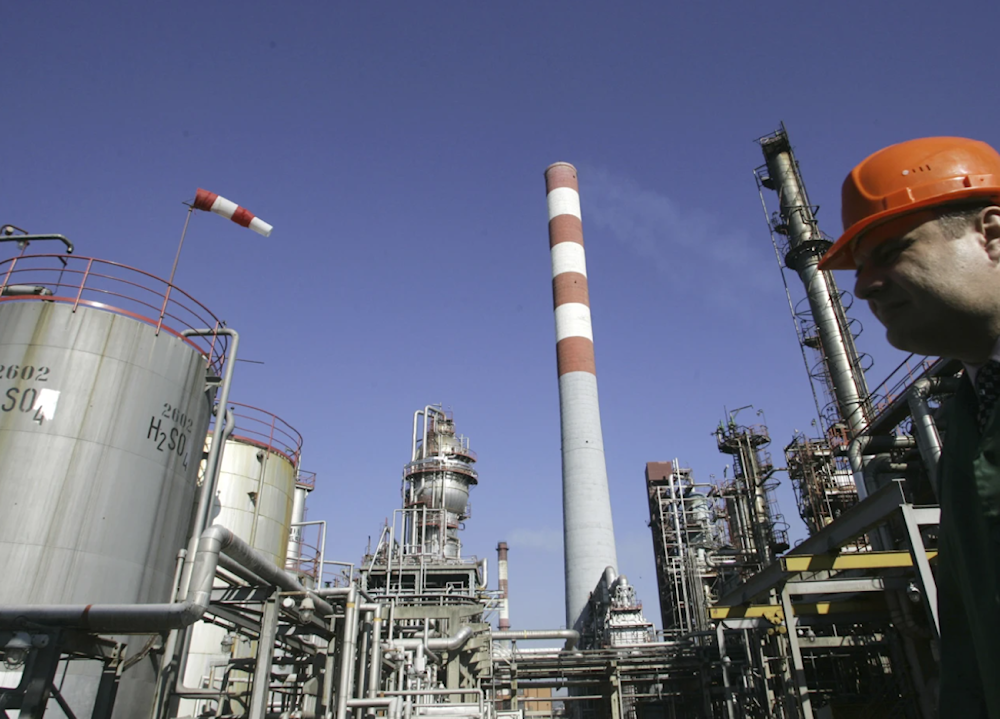Russia, Serbia, Hungary plan new gas pipelines bypassing Ukraine
Russia and Serbia are discussing new gas routes through the Balkans, bypassing Ukraine, while Moscow, Belgrade, and Budapest assess building an oil pipeline linking Serbia to Hungary’s Druzhba network.
-

A worker is seen in the NIS Jugopetrol oil refinery prior to a visit by Russian deputy prime minister Dmitry Medvedev in Pancevo, some 16 km north of Belgrade, Serbia, on February 25, 2008. (AP)
Russia and Serbia are in talks over constructing new gas pipelines that could reshape Southeastern Europe’s energy map by bypassing Ukraine, which has halted the transit of Russian fuel. According to Serbian officials, the new Balkan route would also serve Hungary and Slovakia, offering an alternative supply path amid shifting EU energy policies.
Moscow, Belgrade, and Budapest are additionally conducting a financial assessment for an oil pipeline with a capacity of up to 3 million tons per year, linking Serbia to Hungary’s Druzhba network. Serbian authorities have made clear they do not intend to halt the project, even as the EU plans to end Russian energy imports by 2027.
A source in Serbia’s cabinet told Izvestia that the government and Serbiyagaz are working with Gazprom on possible new pipelines, including a Serbia–Hungary link. This route could expand supplies to EU countries such as Slovakia and Austria.
Serbia’s Ministry of Mining and Energy confirmed it intends to continue receiving maximum volumes of Russian gas via the Balkan Stream, the extension of the Turkish Stream pipeline. In 2024, Serbia sourced 93% of its gas from Russia; in the first half of 2025, that share was over 80%.
Following Ukraine’s refusal to extend Russian gas transit after January 1, Hungary and Slovakia now receive supplies exclusively via the Turkish Stream and Serbia. Flows through this route rose 7% in the first half of 2025 to 8.3 bcm. Other major transit lines, Nord Stream and Yamal-Europe, remain offline due to earlier disputes and sanctions.
EU sanctions pressure and Serbia’s sovereign energy policy
Brussels and Kiev have sought to halt flows via Turkish Stream, including through drone attacks on infrastructure in January, according to Izvestia. Serbian President Aleksandar Vucic and Hungarian Prime Minister Viktor Orban have called protecting the pipeline a strategic priority.
The EU’s planned 2027 cutoff from Russian gas makes a new Serbia–Hungary pipeline a financial risk, experts warn. There is also internal opposition in Belgrade, where some officials advocate gas market liberalization to diversify imports. Serbia is already negotiating to increase Azerbaijani gas supplies to 1 bcm per year and exploring purchases of American LNG via Turkey and Bulgaria.
The West is also pressing Serbia to reduce reliance on Russian energy. The US has sanctioned NIS, Serbia’s main oil company, though enforcement has been delayed until August. Belgrade has offered Moscow the chance to buy out its NIS stake for €600 million to avoid restrictions.
Proposed oil pipeline between Serbia and Hungary
In parallel, Serbia, Hungary’s MOL, and NIS are studying a 180-km oil pipeline from Novi Sad to Szeged, connecting to the Druzhba system. The project is targeted for completion in 2027 and is intended to boost supply security, reduce costs, and bypass transit risks via Croatia.
Serbia currently produces only 20% of its oil needs. Most imports arrive via Croatia’s Janaf pipeline, but EU sanctions prevent direct Russian oil shipments by sea. The proposed Druzhba link would shorten supply routes and shield Serbia from potential Croatian transit disruptions.
However, some Serbian officials question the need for the project, citing limited domestic refining capacity and the possibility of higher raw material costs due to operating two separate supply routes.

 3 Min Read
3 Min Read










